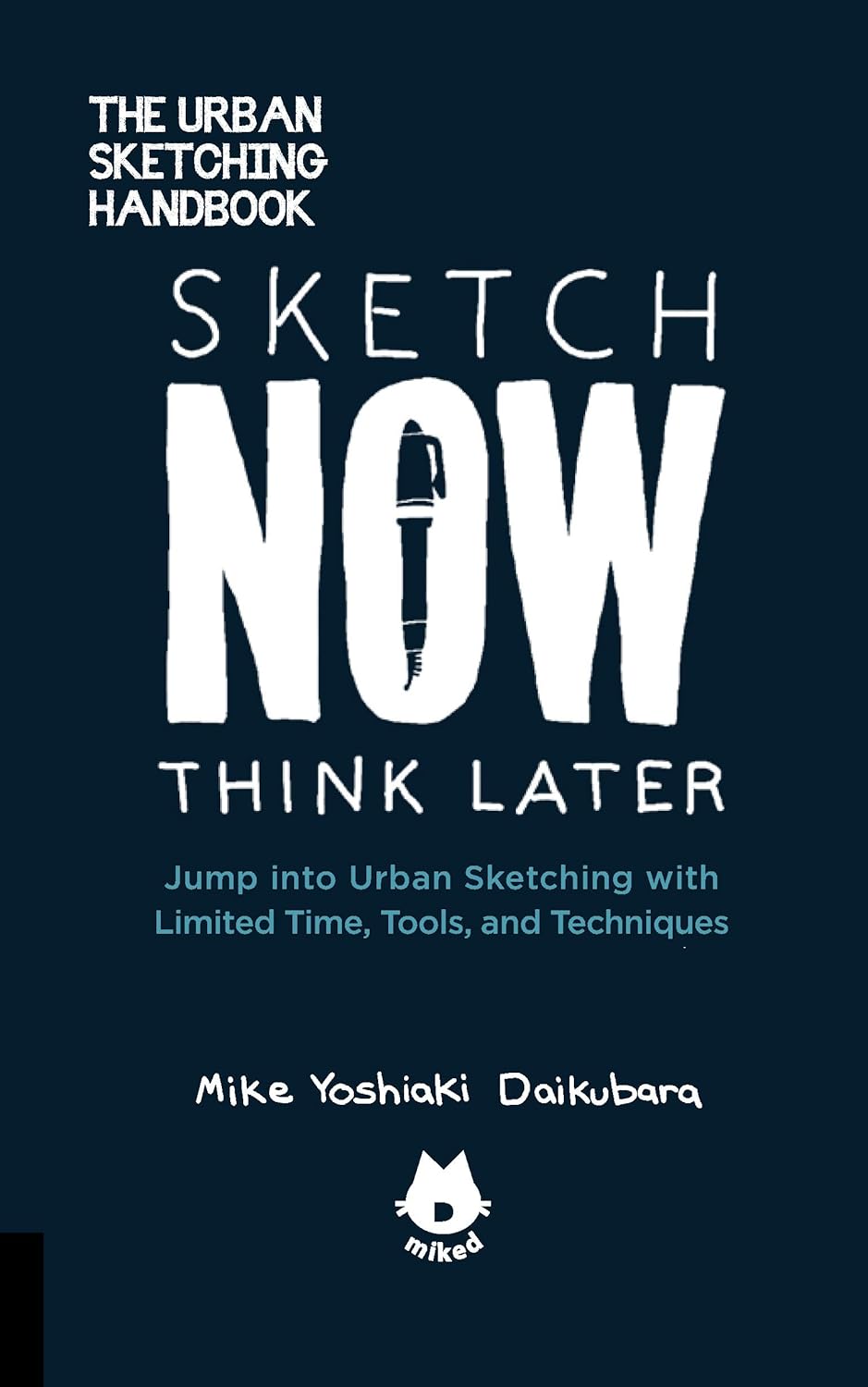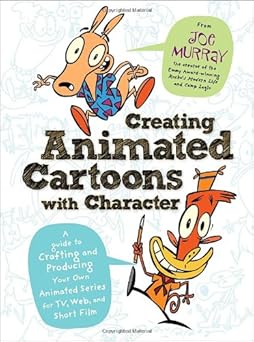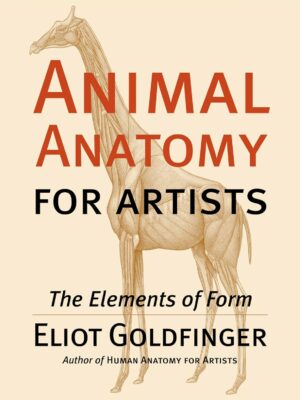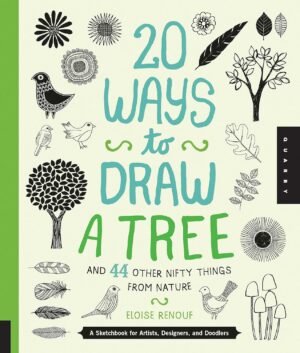Everyone wishes they could sketch stylish scenes, but busy lives leave almost no room for sitting down with a pad and pen to practicing. Many people give up on their potential hobby (and artistic outlet) because they feel they just don’t have the time to lay the groundwork. Here’s a secret though: you do! All you need is a strategy for incorporate sketching into your daily life.
Sketch Now, Think Later covers the tools, techniques and tips that author and Urban Sketching Correspondent of Boston Mike Daikubara has developed in his more than 15 years as a practicing artist, and will show you how to fully dive into any sketching situation with limited time and tools, and still be able to produce memorable, great looking, fun sketches!
Read more
399 reviews for The Urban Sketching Handbook Sketch Now, Think Later: Jump into Urban Sketching with Limited Time, Tools, and Techniques (Volume 5) (Urban Sketching Handbooks, 5)
Add a review

Original price was: $18.99.$16.07Current price is: $16.07.








BruinRumble –
What an excellent resource for beginners and not-beginners alike! I’m an illustrator by trade who stumbled on this book as recommended by another artists blog (James Richards). This book lists out exactly what you need to start your own watercolor sketches and imparts how important mistakes are. Beginners often think that they need to make the final product with the first stroke, and immediately erase to get that line perfect. Don’t! Create that bad line, then create another bad line, then maybe make a good line or two and pretty soon you’re gonna have a page filled with visual texture, so then fill in some lighting with color that is based on an existing scene, and voila! You now have a finished piece! It’s okay if it sucks, if we’re being honest, most art does! But you learn something!
I bought this originally because it is a medium that I have wanted to try since it is such a “portable” medium. However, as I was thumbing through, not only did I learn a bunch, but Mike laid out everything for the beginner and I realized this would be perfect for my retired dad who is just now beginning to paint. Well, sometimes, we don’t take to advice from our closest relatives and friends, and I anticipate that, so I look for other sources that can articulate my own thoughts. Mike does way better than I could ever attempt, so, full disclosure, there are now two copies owned by our family!
When most of us start our journey we strive to produce representationally accurate drawings and pride ourselves in the technicality that can bring. This book is great because it depicts “loose drawing” which is where true emotion is born. The novice will get caught up in detail, and detail is fun to show off to friends; realism is a great way to show how technically good you are. But to capture a scene that conveys emotion and the whimsy of the movement in a band of musicians, THAT is created through wandering ink paths, and I believe that’s what this book is a great example of. It is a broad guide for you to choose your own path, and Mike lays out the tools you need to create your own trail.
In my years at art school the most beneficial lessons I was taught were by my peers and their sketchbooks and processes. Luckily Mike took the time out of his life to display his. Brilliant book, brilliant images, and it is phenomenal that we get to enjoy his efforts.
K. Padgett –
I absolutely devoured this book. I read it cover to cover in 2 sittings, taking notes of Mike’s best ideas in the front. Now I use it as a reference. I already had a lot of the equipment he recommends (often simple things like tissues, a fanny pack, fingerless gloves) to make a sketch kit that makes it super easy to sketch anytime anywhere. Since reading the book, I have had 4 urban sketching opportunities, including 2 Sketch Crawls I organizes after getting so inspired to “see, understand, and enjoy,” as he so aptly says.
Mike’s website, Daikubara.com, is also a great resource, even including a downloadable (for a fee) 3-d printer program for a nice sturdy insert for my Sakura Koi travel watercolor kit. And when I emailed mike with a question, he responded within a few hours with a specific, encouraging answer.
So maybe I’m reviewing mike as much as I’m reviewing his book. Urban sketchets are a world-Wide community, though, so that’s appropriate—you get a real live human connection to the urban sketching community along with this book. You couldn’t ask for a better deal!
Oh, I love too they the book is soft-ish cover, can open flat (like a sketchbook), is big enough to read and small enough to fit in my purse, and has an elastic loop built in to mark my place.
shivz –
Great book filled with tips for outdoor sketching good book to own
A. Rudolph –
I have a large collection of how to books on urban sketching and watercolor. Some are better than others. I am a student of landscape sketching and watercolor. I have taken classes for a several years now, I am always looking for a teacher who can show me how to draw and paint better. Most books on urban sketching say they are for beginners as well as experienced artists. The books assume way to much on the part of the student. When it comes down to it these books are showcases of the authors artwork, not how to. They all start out with the same thing, here are some nice photos of the equipment I use, paints, pencils, blank sketch books etc. Some give a few step by step illustrations then take off with beautiful finished paintings. I love looking at the paintings but I want to learn how.
This author shows you how to. Mike is opinionated and tells you exactly what he uses then how he carries his kit around. Next he goes into a very clear simple 2-3 pages on perspective, basically all you need to know. He uses a pen, not a pencil because he uses artists to keep going even if they make a mistake something every professional teacher I have had urges. All of my teachers have said to always keep going on a sketch or drawing, never tear it up there is always a way to keep going and finish. Mike is an author but he is also a teacher. His art is really wonderful and enjoyable and he shows you how to do it. Not that he wants you the student to copy his style, on the contrary he urges you to keep going, sketch sketch sketch. Always carry your sketch book. I really appreciate his teaching style or should I say his writing style. I think my search for instruction books is over. Buy the book, it is a convenient size, just like a sketchbook.
Placeholder –
Fantastic read.. it’s almost like Mike is sharing all his knowledge and expertise in person.. the technique are simplified and can be readily implemented..
William Davis –
Although brief, this primer is an excellent source of beginner knowledge and motivation. I really enjoyed the artist’s work as well.
J BT –
Good information in a summary format
FG –
Conforme
Patrice A –
I read through the entire book. There was good solid advice and suggestions in the book for sure. The sketches were fun to look at and study after reading some of the related text. I am glad I bought the book to read, however, this, is not a book I will go back to reread. After spending some time with the book, I passed it along.
T Elrod –
I have purchased many art books over the years and this is my all-time favourite. I refer back to it often. It rightly advises that the best way to enjoy sketching and get good at it is to get out there and do it. It begins with excellent advice about a simple and portable set of tools to use and get to know very well. It also recognizes that sketching a living and moving world rewards quickness, which also helps fit sketching into a busy life.
The book is very informative and holds nothing back in terms of specific suggestions for materials, subjects and techniques. Yet it is also very well organized and avoids overwhelming the reader.
The author’s tone is friendly and encouraging. He is a superb sketcher and the book contains many examples of his work that are well connected to the text. More examples of his work and other information are to be found on his website. My favourite quote from the book encourages sketchers to dive in, trusting to instinct and experience and the feeling of the moment: “Don’t overthink; you know what to do.”
I have been an en plein painter and sketcher off and on for many years, but this book encouraged me to do more of it and provided much helpful guidance. As I result, I have happily sketched 139 scenes in the seven months since I purchased it, using the equipment and techniques he recommends.
If you want to have fun sketching your world, then this book is an excellent choice, even if you already lead a busy life.